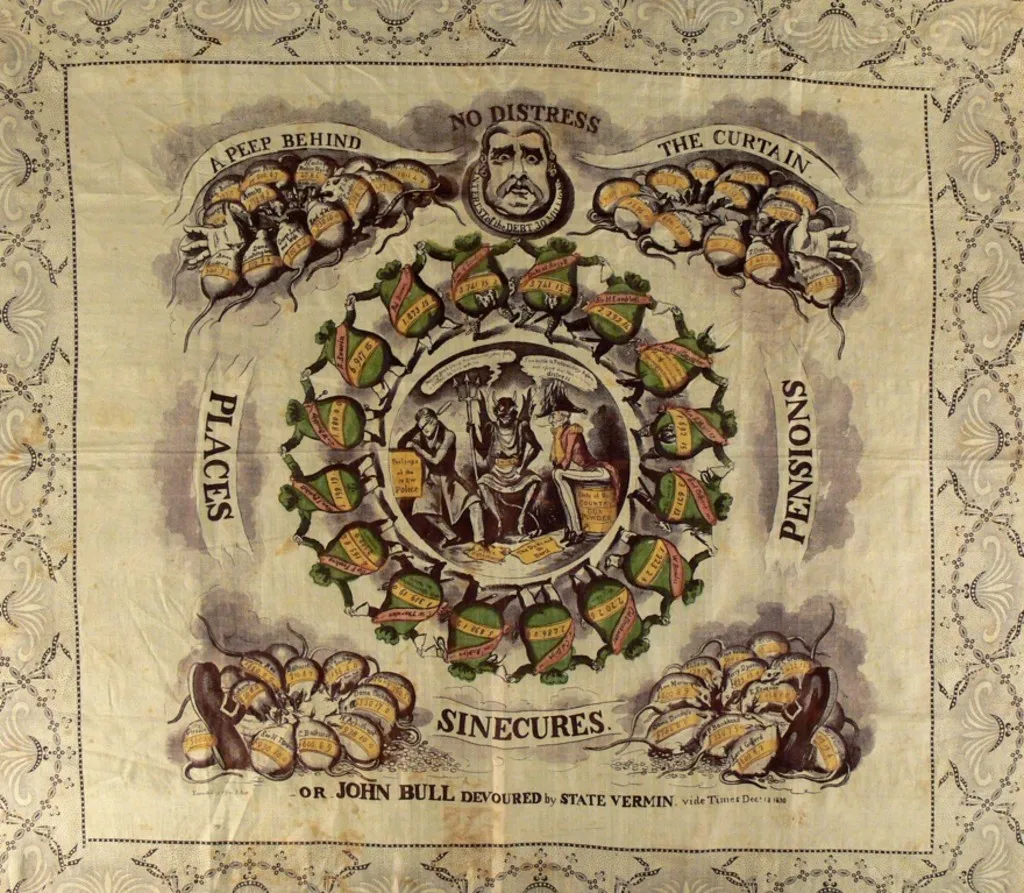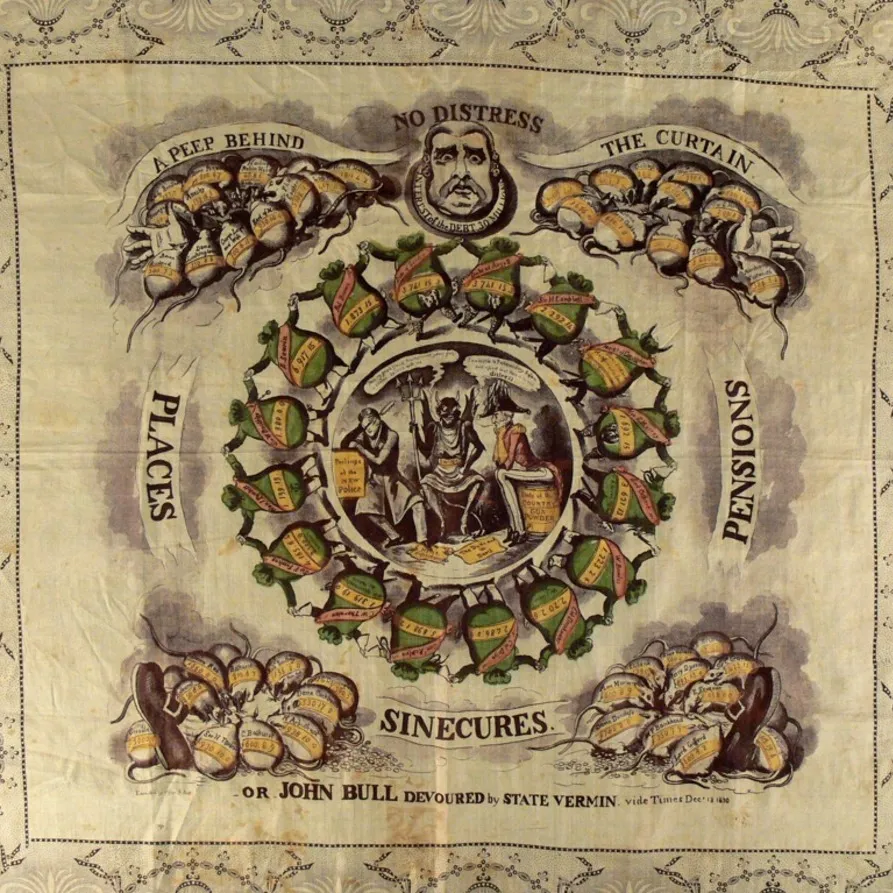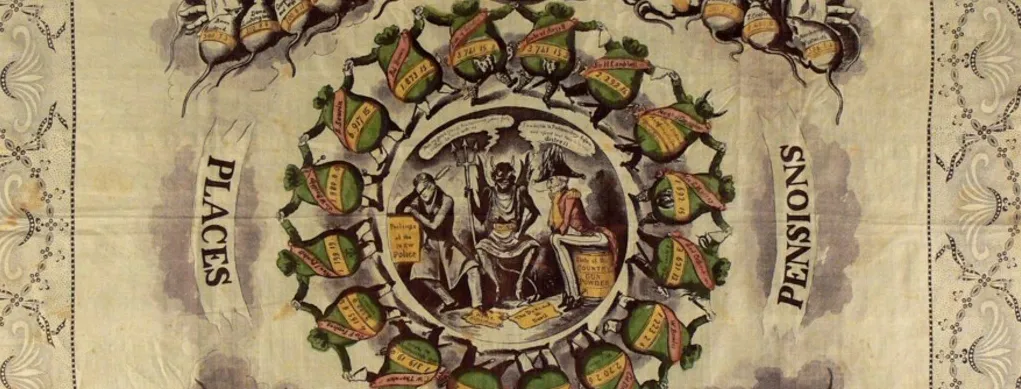A peep behind the hankie
- DateFri, 05 Jun 2015
‘Society is founded upon cloth’ said Scottish historian and philosopher Thomas Carlyle.
At the Museum of Australian Democracy we’re interested in exploring how cloth and clothing encodes, embodies and expresses power: who has it, in what context, and why. And we want to know to what extent our fashion choices are inherently political acts.
Handkerchiefs are often highly encoded forms of clothing—even fashion items (think cravats, bandanas and pocket squares). But one hankie in our collection lacks the usual printed posies, manly monograms or fluffy ducks. It is somewhat lacking in lavender-and-lace daintiness. Instead, our hankie depicts rats feasting on the flesh of a living man while bags of money dance hand-in-hand around a former prime minister sitting on a powder keg and chatting with a Devil called Swing.
It’s probably not the sort of thing your nanna tucked up her sleeve.
This silk handkerchief was created in England in late 1830 or early 1831, a time of extreme social inequality and political ferment. The electoral system meant that only men who owned property or paid certain taxes could vote. Electoral boundaries had failed to keep pace with population shifts: burgeoning industrial towns like Manchester, Birmingham and Leeds had no parliamentary representation, while some constituencies with depopulated electorates retained their original quota of MPs. One such ‘rotten’ borough (so-called to convey a sense of corruption as well as decline) had seven voters and two MPs! There was no secret ballot, so men who could vote could also be intimidated or bribed. Some constituencies, called pocket boroughs, were controlled by major landowners who could influence their tenants to vote as they wished. Meanwhile, a plethora of pensions, sinecures and jobs for the boys meant the rich got richer and the poor got the picture—in this case, quite literally.
The hankie illustrates the corruption at the heart of Britain’s system of government. The cartoon (‘Executed by a poor Artist’, it says) is titled ‘A Peep Behind the Curtain; or John Bull Devoured by State Vermin’. John Bull wears a yoke labelled ‘Interest of the Debt 30 Million’, and the gorging rats and dancing money bags are all labelled with the names of people receiving civil list pensions and other dubious payments. The cartoon refers to a letter to the Editor of the Times published on 13 December 1830. Written by ‘Radical’, the letter methodically details the many questionable civil list recipients. Those on the English list alone received more than a whopping £70,010 per annum, with some pensions dating back 46 years! One example is a Robert Brown who, ‘Radical’ pointed out, received £1350 per annum as chief examiner of the War Office and also £250 ‘as Agent for paying retired officiating chaplains’ and £273 15s ‘by being allowed, against the regulations, to draw his half-pay as deputy commissary general’: a small fortune of £1873 15s per annum. Mr Brown is depicted on the hankie as a dancing money bag. ‘When the above list is examined,’ wrote ‘Radical’, ‘can any one doubt whence the present discontent arises, and why there are such loud complaints against the burden of taxation?’
With its horrid imagery and lurid green and yellow inks, still ghastly today, the hankie conveys some of the anger and disgust felt by working people of the time. It was not just the boroughs that were rotten but also John Bull, the personification of Britain. Radical reformers argued that giving working men the right to vote would lead to fairer taxes and better use of public money. As the Swing Riots raged across rural Britain, it is fitting our ‘poor Artist’ depicted the recently ousted anti-reform prime minister, the Duke of Wellington, sitting on a keg of gun powder labelled ‘State of the Country’.

Credit: MoAD collection.
But the hankie is doubly revolutionary: a political statement on cloth that itself is a piece of political activism. After the massacre of unarmed protestors at a public rally in Manchester in 1819 (the Peterloo Massacre), the government passed the Six Acts, a draconian crackdown designed to repress meetings, protests and any other treasonable conspiracies against the King and his government. These included the Newspaper and Stamp Duties Act, which greatly increased taxes on newspapers, periodicals and pamphlets. It was supposed to suffocate Radical writing, but journalists simply found more creative ways to get their point across. Cloth was handy, so to speak, because it was not subject to the stamp duty imposed on paper.
In September 1831 Henry Berthold, the leader of Britain’s National Union of Working Classes, used this loophole to his advantage when he printed the first issue of his newspaper, Berthold’s Political Handkerchief, on cotton. ‘We have no patent for this new pocket handkerchief,’ his hankies read, ‘because we intend to advocate the interest of the working people, and consequently do not intend to pay any tax for our knowledge to the tyranny that oppresses us.’ In much the same way, our ‘Peep Behind the Curtain’ hankie shows allegiance to the reformist cause. It protests against the haemorrhaging of hard-earned taxes while simultaneously thumbing its nose at the ruling class by circumventing their tax. The hankie could also be easily hidden by a person fearing arrest for possessing what the authorities considered seditious libel.
Concealed or revealed as required, a private item or a public statement, the hankie may have helped spread the message amongst people who could not afford to buy or hire newspapers or pamphlets, or to go to a coffee house to read one, or perhaps could not read. Certainly, the image of John Bull being eaten alive requires few words. Alternatively, the silk hankie may have been purchased by someone from the emerging middle class to raise money for the cause (commemorative handkerchiefs were sold after the Peterloo Massacre). Perhaps it was bought by a business owner in the industrial North who had no MP and no say in how his taxes were spent – or squandered. Although the hankie (thankfully) bears no evidence of practical use, the act of blowing one’s nose on the feasting rats and dancing bags would have similarly been an expression of protest and defiance. This radical handkerchief joins the personal and the political via the warp and weft of cloth.









